Karur | |
|---|---|
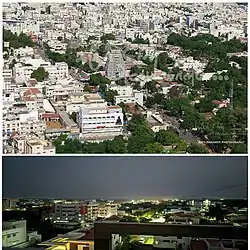 | |
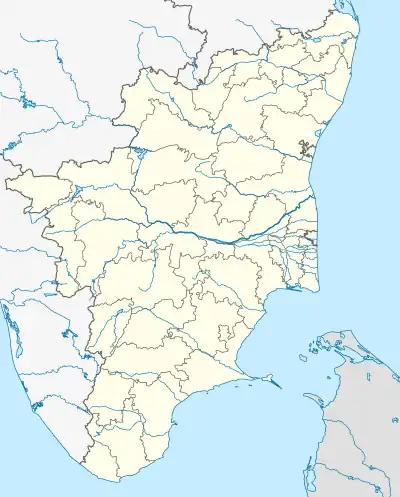 Karur Karur, Tamil Nadu 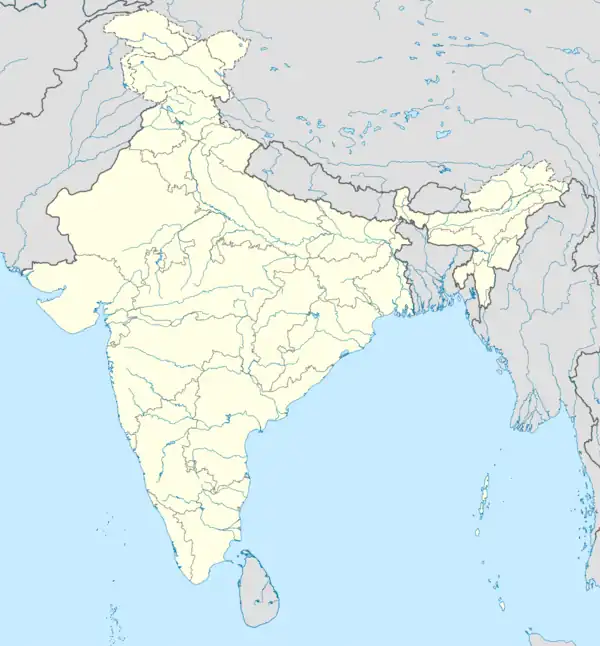 Karur Karur (India) | |
| Coordinates: 10°57′36″N 78°04′36″E / 10.960100°N 78.076600°E | |
| Country | |
| State | Tamil Nadu |
| District | Karur |
| Government | |
| • Type | Municipal Corporation |
| • Body | Karur City Municipal Corporation |
| • Member of Parliament | Jothimani[1] |
| • Member of Legislative Assembly | V. Senthil Balaji[2] |
| • Corporation Commissioner | N. Ravichandran |
| Area | |
| • City | 53.26 km2 (20.56 sq mi) |
| Elevation | 147 m (482 ft) |
| Population (2021) | |
| • City | 358,468 |
| Languages | |
| • Official | Tamil |
| Time zone | UTC+5:30 (IST) |
| PIN | 639(xxx) |
| Telephone code | 91-(0)4324 |
| Vehicle registration | TN-47 |
Karur (Tamil: [kaɾuːɾ]) is a city in the Indian state of Tamil Nadu. Karur is the administrative headquarters of Karur district. It is located on the banks of River Amaravathi, Kaveri and Noyyal. Karur is well known for the export of Home Textile products to USA, UK, Australia, Europe and many more countries. It is situated at about 395 kilometers southwest of the state capital Chennai, 75 km west from Tiruchirappalli, 120 km away in east from Coimbatore, 150 km away north from Madurai, 295 km away southeast from Bengaluru and 300 km away northeast from Kochi.
Etymology
Karur is mentioned in inscriptions and literature by two names, Karuvoor (the home of Karuvoor Devar) and Vanji. Additionally, it has been referred to as: Adipuram, Tiruaanilai, Paupatheechuram, Karuvaippatinam, Vanjularanyam, Garbhapuram, Thiru vithuvakkottam, Bhaskarapuram, Mudivazhangu Viracholapuram, Karapuram, Aadaga maadam, Cherama nagar and Shanmangala Kshetram. Among them, the name Adipuram, meaning the first city seems to indicate that it was held as the foremost city by the medieval writers. It was also called Vanchi moothur, the ancient city of Vanji. In the foreign notices of Ptolemy, it was called Karoura – an inland capital of the Cheras.[3]
History

Karur has been ruled at different times by the Murkala Cheras (before the sangam period) before the kodungalur Cheras, Later Cholas, Vijayanagar Empire, Madurai Nayaks, Mysore Kingdom and the British.
Karur is one of the oldest towns in Tamil Nadu[4] and has played a very significant role in the history and culture of the Tamils. The history dates back to the Sangam period when it was a flourishing trade centre. Karur was built on the banks of river Amaravathi which was called Aanporunai during the Sangam days. According to Hinduism, Brahma began the work of creation here, which is referred to as the "place of the sacred cow.". Karuvur, identified with Karur, was also the capital of the ancient king Musuguntha Solan.[5]
Epigraphical, archaeological and literary evidence indicate that Karur was the capital of early Chera kings of Sangam age. The names of early Chera kings who ruled from Karur have been found in the rock inscriptions in Aaru Nattar Malai close to Karur. The Tamil epic Silapathikaram mentions that the famous Chera King Senguttuvan ruled from Karur. The archaeological excavations undertaken in Karur resulted in the excavation of mat-designed pottery, bricks, mud-toys, Roman coins, Chera coins, Pallava coins, Roman Amphorae, Rasset coated ware and rare rings.[6] Karur might have been the center for old jewellery-making and gem setting (with the gold imported mainly from Rome), as seen from various excavations. In 150 CE, Greek scholar Ptolemy mentioned "Korevora" (Karur) as a very famous inland trading center in South India.[7] It was ruled by the Cheras, Western Gangas, Cholas, the Vijayanagara Nayaks, Tipu Sultan and the British successively.[3]
Karur municipality was constituted in 1874. It was upgraded to a I grade municipality on 24.10.69, upgraded to selection grade municipality on 24.05.1988, and upgraded to a special grade municipality on 07.04.1988. The town is very expanded now, with 48 wards, much like a city corporation.[8]
Geography
Karur is located at 10°57′N 78°05′E / 10.95°N 78.08°E[9] and has an average elevation of 101 metres or 331 feet. The town is located in Karur district of the South Indian state, Tamil Nadu, at a distance of 370 km (230 mi) from Chennai.
Topography
Karur is located on the banks of the Amaravathi River and noyyal river. The topography is almost plain, with no major geological formation.
Geology
There are no notable mineral resources available in and around the town. The soil types are black and red that are conducive for common crops in the Cauvery delta.
Climate
The prevailing climate in Karur is known as a hot semi-arid climate, labelled BSh under the Köppen and Geiger classification system. Karur receives an average of 590 to 600 mm (23 to 24 in) annually, which is substantially below the state average of 1,008 mm (39.7 in). The South West monsoon, with an onset in June and lasting up to August, brings scant rainfall since Karur is in a rainshadow region. The bulk of the rainfall comes during summer months (late April, May) and the North East monsoon in the months of October, November and December.[3][10] The driest month is March, with only 8 millimetres or 0.31 inches of rain. Most rain falls in October, with an average of 166 millimetres or 6.54 inches. The precipitation varies 158 millimetres or 6.22 inches between the driest month and the wettest month.
The average temperature in Karur is 28.7 °C or 83.7 °F. The temperature ranges from a maximum of 39 °C (102.2 °F) to a minimum of 17 °C (62.6 °F). Like the rest of the state, April to June are the hottest months and December to January are the coolest. The average temperatures vary during the year by 5.9 °C or 10.6 °F. With an average of 31.5 °C or 88.7 °F, May is the hottest month, whilst in the mildest months of December the average temperature is 25.6 °C or 78.1 °F.
| Climate data for Karur | |||||||||||||
|---|---|---|---|---|---|---|---|---|---|---|---|---|---|
| Month | Jan | Feb | Mar | Apr | May | Jun | Jul | Aug | Sep | Oct | Nov | Dec | Year |
| Mean daily maximum °C (°F) | 31.1 (88.0) |
33.7 (92.7) |
36.2 (97.2) |
37.0 (98.6) |
37.1 (98.8) |
35.6 (96.1) |
34.3 (93.7) |
34.2 (93.6) |
33.9 (93.0) |
32.5 (90.5) |
30.7 (87.3) |
29.4 (84.9) |
33.8 (92.9) |
| Daily mean °C (°F) | 25.8 (78.4) |
27.5 (81.5) |
29.7 (85.5) |
31.3 (88.3) |
31.5 (88.7) |
30.6 (87.1) |
29.6 (85.3) |
29.4 (84.9) |
29.1 (84.4) |
28.1 (82.6) |
26.6 (79.9) |
25.6 (78.1) |
28.7 (83.7) |
| Mean daily minimum °C (°F) | 20.5 (68.9) |
21.3 (70.3) |
23.2 (73.8) |
25.7 (78.3) |
26.0 (78.8) |
25.6 (78.1) |
24.9 (76.8) |
24.6 (76.3) |
24.3 (75.7) |
23.7 (74.7) |
22.5 (72.5) |
21.8 (71.2) |
23.7 (74.6) |
| Average rainfall mm (inches) | 11.5 (0.45) |
9.2 (0.36) |
8.3 (0.33) |
32.4 (1.28) |
63.5 (2.50) |
17.1 (0.67) |
30.2 (1.19) |
44.6 (1.76) |
63.2 (2.49) |
166.3 (6.55) |
86.3 (3.40) |
61.0 (2.40) |
593.6 (23.38) |
| Average rainy days | 2 | 1 | 1 | 3 | 5 | 2 | 3 | 4 | 6 | 10 | 9 | 6 | 52 |
| Source 1: Climate-Data.org[11] | |||||||||||||
| Source 2: rainy days | |||||||||||||
Flora and Fauna
Demographics
Karur urban area is the 15th Populous city in the state of Tamil Nadu. Karur City Area divided into Three Regions Karur, Inam karur and Thanthoni Region which is further divided into 12 divisions. Currently Karur City has population about 3,58,468 (population before corporation 2021) with a sex-ratio of 1,032 females for every 1,000 males, much above the national average of 929.[12] A total of 6,147 were under the age of six, constituting 3,162 males and 2,985 females. Scheduled Castes and Scheduled Tribes accounted for 12.11% and .08% of the population respectively. The average literacy of the city was 81.71%, compared to the national average of 72.99%.[12] The city had a total of 57,687 households. There were a total of 30,216 workers, comprising 125 cultivators, 181 main agricultural labourers, 469 in household industries, 26,660 other workers, 2,781 marginal workers, 24 marginal cultivators, 82 marginal agricultural labourers, 140 marginal workers in household industries and 2,535 other marginal workers.[13] As of 2001, 13 slums were identified in the town.[14] As per the religious census of 2011, Karur (M) had 91.41% Hindus, 5.62% Muslims, 2.88% Christians, 0.01% Sikhs, 0.01% Buddhists, 0.07% following other religions and 0.01% following no religion or did not indicate any religious preference.[15]
The city covers an area of 30.96 square kilometres (11.95 sq mi). More than 8% of the total population of the Karur district and 25% of the total urban population in the district resides in the town. The town has a large floating population. Out of the total area, 86.85% of the land is marked developed and 37.63% of the city remains undeveloped. Residential areas make up 39.41% of the town's total area while commercial enterprises and industrial units make up 4.72% and 1.99% respectively.[16]
The population density of the city in the 2001 census was 128 persons per hectare and the average household size was 3.95 as of 2001. Hindus form the majority of the urban population, followed by Muslims and Christians. Tamil is the main language spoken in the city, but the use of English is relatively common; English is the medium of instruction in most educational institutions and offices in the service sector.[17]
Government and politics
| Municipal Corporation officials | |
|---|---|
| Mayor | Tmt. Kavitha Ganesan |
| Corporation Commissioner | N. Ravichandran[18] |
| Deputy Mayor | Thiru. Dharani Saravanan Dravida Munnetra Kazhagam |
| Elected members | |
| Member of Legislative Assembly | V. Senthil Balaji[19] |
| Member of Parliament | Jothimani |
Karur is the headquarters of the Karur District. The town was constituted as a municipality in 1874, promoted to first-grade during 1969, selected-grade during 1983 and special-grade as of 1988. The Karur municipality has 48 wards and there is an elected councillor for each of those wards.[20] The functions of the municipality are devolved into six departments: general administration/personnel, Engineering, Revenue, Public Health, city planning and Information Technology (IT). All these departments are under the control of a Municipal Commissioner who is the executive head.[21] The legislative powers are vested in a body of 48 members, one each from the 60 wards.[22] The legislative body is headed by an elected Chairperson assisted by a Deputy Chairperson.[23] On 24 August 2021, the government announced the upgrading of Karur municipality to Karur City Municipal Corporation.[24]
Karur is a part of the Karur assembly constituency and it elects a member to the Tamil Nadu Legislative Assembly once every five years.[25] From the 1977 elections, All India Anna Dravid Munnetra Kazhagam (AIADMK) won the assembly seat five times (in 1977, 1980, 1984, 1991, 2006 and 2011 elections) and two times by Dravida Munnetra Kazhagam (DMK, 1989 and 1996) and Indian National Congress (INC) won once during 2001 elections. The current MLA of Karur constituency is V. Senthil Balaji from the DMK party.[19][26]
Karur is a part of the Karur (Lok Sabha constituency). From 1957, the Karur parliament seat was held by the Indian National Congress for eight times (during 1957, 1962, 1967, 1971, 1977, 1980, 1984 and 2019 elections), ADMK for six times (during 1989, 1991, 1998, 1999, 2009 and 2014 elections), Tamil Maanila Congress once (during 1996 elections) and Dravid Munnetra Kazhagam once (during the 2004 elections). [27][28][29][30][31][32][33][34][35][36][37][38][39] The current Member of Parliament from the constituency is S.Jothimani from Indian National Congress.[40]
Law Enforcement
Law and order in the city in maintained by the Karur sub division of the Tamil Nadu Police headed by a Superintendent of Police. There are 4 police stations for law and order, 2 for traffic and 1 all women police station and more than 10 police outpost in the city, There are special units like prohibition enforcement, district crime, social justice and human rights, district crime records and special branch that operate at the district level police division headed by a Superintendent of Police.[41]
Utilities
Electricity supply to Karur is regulated and distributed by the Tamil Nadu Electricity Board (TNEB). The city along with its suburbs forms the Karur Electricity Distribution Circle. A Chief Distribution engineer is stationed at the regional headquarters.[42] Water supply is provided by the Karur Municipality from the Cauvery river through Chinnandan Kovil head water work and Thirumanilaiyur water pumping station. In the period 2000–2001, a total of 7 million litres of water was supplied every day for households in the town.[43]
As per the municipal data for 2011, about 45 metric tonnes of solid waste were collected from Karur every day by door-to-door collection and subsequently the source segregation and dumping was carried out by the sanitary department of the Karur municipality. The coverage of solid waste management in the town by the municipality had an efficiency of 100% as of 2001.[44] There is no underground drainage system in the town and the sewerage system for disposal of sullage is through septic tanks, open drains and public conveniences.[45]
The municipality maintained a total of 115 km (71 mi) of storm water drains in 2011.[46] As of 2011, there is one government medical college hospital, one municipal dispensary, 19 private dispensaries, one ESI dispensary, one municipal Siddha centre, two Ayurvedic clinics, three private general clinics, one private skin care clinic, nine private ENT clinics and one private tuberculosis clinic that take care of the health care needs of the citizens.[47] As of 2011, the municipality maintained a total of 2,584 street lamps: 706 sodium lamps, 151 mercury vapour lamps, 2,274 tube lights and three high mast beam lamp.[48] The municipality operates three markets, namely the Gandhi Market, Kamaraj Market and Uzhavar Santhai that cater to the needs of the town and the rural areas around it.[49]
Arts, society and culture

The town formed a part of the traditional Chera and Chola empires and has a number of exquisitely sculpted temples. Karuvurar born in medieval Karur, is one among the nine devotees who sung the divine Music Thiruvichaippa, which is the ninth Thirumurai. He is the single largest composer among the nine authors of Thiruvichaippa. He lived during the reign of the Chola king Raja Raja Chola I. In addition to the Pasupatheeswarar Siva temple, there is a Vishnu temple at Thiruvithuvakkodu suburb of Karur, sung by famous Kulasekaraazhvaar (7th-8th century CE). The same temple is presumably mentioned in epic Silappadikaram as Adaha maadam Ranganathar whose blessings Cheran Senguttuvan sought before his north Indian expedition.[50][51]
Economy
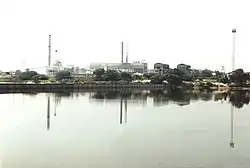
The city has about 19% of its total area under agricultural land use. The major crops are rice, cotton, sugar cane and oil seeds, while the major horticultural crops are coconut, banana, betel and mango. The town is the commercial centre for trading of agricultural commodities from the nearby towns and villages. Karur, being the headquarters of the district, has registered growth in tertiary sectors, with a corresponding decrease in the primary sector. Approximately 80 per cent of the workforce is employed in tertiary sector, 17 per cent in primary sector and 4% in secondary sector activities.[52]
All major government and private banks have branches at Karur. Private banks Karur Vysya Bank and Lakshmi Vilas Bank have their headquarters in Karur.
Home Textiles
Karur is a major home textile centre and has five major product groups — bed linens, kitchen linens, toilet linens, table linens and wall hangings. The city generates around ₹10000 crores. More than 1.5 Billion US$ in foreign exchange through direct and indirect exports. Major importers are Walmart, Sears in the US, IKEA in Sweden and other major retailers in the UK. Allied industries like ginning and spinning mills, dyeing factories and weaving employ around 300,000 people in and around Karur.[53] Hand-loom Exports from Karur began on a modest scale with just 15 exporters in 1975.[52] Karur is also home to an integrated textile park, ₹190 crore Karur Textile Park Limited (KTPL) a premier facility of its kind in the country for its technical and ancillary facilities.[54]
Bus Body manufacturing
Karur is a major hub for Bus Body [coach] building in South India, with a major market share of almost 70% of bus coaches being built here locally.[55] The total business turnover from building bus coaches is estimated to be around ₹1000 crore per annum.
Mosquito nets
About 60% of mosquito nets in India are manufactured in Karur. About 2000 units are engaged in making High-density polyethylene (HDPE) mono filament yarn and associated products and employ about 50,000 people.[56]
Newsprint
TNPL promoted by the Government of Tamil Nadu with loan assistance from the World Bank, located near Karur, is the largest producer of bagasse (sugarcane waste from Sugar mills) based paper in the world and the second-largest paper producer in Asia. The firm produces more than 400,000 tonnes of printing and writing paper per annum and consumes 1 million tonnes of bagasse every year.
Others
Bharat Petroleum Corporation formed a joint venture with Petronet CCK and has installed a pipeline facility from Cochin to Karur for transporting petroleum products. The petroleum products received at the BPCL-Karur terminal in Athur is supplied to more than 20 districts of Tamil Nadu through tanker trucks.[57] Chettinad group has established a wet process cement plant at Puliyur near Karur with a capacity of 1.7 MTPA.[58]
Transport
Road
The Karur corporation maintains 59.02 km (36.67 mi) of roads. The city has 17.77 km (11.04 mi) concrete roads, 0.53 km (0.33 mi) WBM roads, 0.57 km (0.35 mi) gravel roads and 40.15 km (24.95 mi) bituminous road. A total of 9.51 km (5.91 mi) of state highways is maintained by the State Highways Department and 7 km (4.3 mi) of national highways by the national highways department.[59][60]
There are 2 national highways namely the NH 44 (new numbering) National Highway 7 (India)(old numbering) (Varanasi - Kanyakumari road (now called NSC North–south corridor road NH 44) and NH 67 Nagapattinam - Gudalur road that pass via Karur. It connects the city with all other parts of the country.
Karur bus stand is a B-grade bus stand located in the center of the town. The State Express Transport Corporation operates long-distance buses connecting the city to important cities like Chennai, Bangalore, Thiruvananthapuram, Thirupathi, Nagercoil, etc. Apart from this, Tamil Nadu State Transport Corporation operates city and moffusil busses from Karur to other parts of Tamil Nadu and neighbourhood states. Karnataka State Road Transport Corporation and Kerala State Road Transport Corporation also operates few busses to and from Karur. Karur is situated at the centre of Tamil Nadu so you can reach any part of Tamil Nadu within seven hours.
Railway
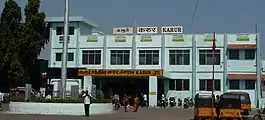
Karur Junction railway station (station code - KRR) is one of the railway junctions under the Salem division of the Indian Railways network. It is an A grade junction in Salem railway division. It has 5 active Platforms and forms the intersection between Erode-Tiruchirapalli, Erode-Madurai and Salem-Karur.[61][62][63][64] railway lines.
Airport
The nearest local and international airport is the Tiruchirapalli International Airport, located 78 km, Coimbatore International Airport, located 121 km & Salem Airport, located 116 km away from the city.
Education
There are 72 government and private schools, 1 government arts college, 1 government medical college and number of private arts and science, architecture, engineering, polytechnic, Teacher training, nursing, catering colleges and large number of engineering colleges are in and around Karur. Karur medical college has recently been established at the cost of 115 crores.
Private schools
See also
Notes
- ↑ "Lok Sabha". Archived from the original on 24 November 2014. Retrieved 22 November 2012.
- ↑ "Archived copy" (PDF). Archived from the original (PDF) on 12 December 2014. Retrieved 22 November 2012.
{{cite web}}: CS1 maint: archived copy as title (link) - 1 2 3 Urban Infrastructure Report 2006, p. 4
- ↑ "History | Karur District, Government of Tamil Nadu | India". Retrieved 9 September 2020.
- ↑ R. K. Das. Temples of Tamilnad. Bharatiya Vidya Bhavan, 1964. p. 161.
- ↑ R., Nagaswami (1995). Roman Karur: A peep into Tamil's past. Madras: Brahad Prakashan.
- ↑ "Chera Roman coins". The Hindu. Chennai, India. 4 February 2008. Archived from the original on 12 February 2008. Retrieved 7 July 2013.
- ↑ "About Karur municipality". Karur Municipality. Archived from the original on 30 November 2012. Retrieved 7 July 2013.
- ↑ "Location of Karur". Falling Rain Genomics, Inc - Karur. Retrieved 7 July 2013.
- ↑ "About Karur municipality". Karur Municipality. Archived from the original on 5 May 2014. Retrieved 7 July 2013.
- ↑ "climate: Karur – Climate graph, Temperature graph, Climate table – Climate-Data.org". Climate-Data.org. Retrieved 24 September 2015.
- 1 2 "Census Info 2011 Final population totals". Office of The Registrar General and Census Commissioner, Ministry of Home Affairs, Government of India. 2013. Retrieved 26 January 2014.
- ↑ "Census Info 2011 Final population totals - Karur". Office of The Registrar General and Census Commissioner, Ministry of Home Affairs, Government of India. 2013. Retrieved 26 January 2014.
- ↑ Urban Infrastructure Report 2008, p. 60
- ↑ "Population By Religious Community - Tamil Nadu" (XLS). Office of The Registrar General and Census Commissioner, Ministry of Home Affairs, Government of India. 2011. Retrieved 13 September 2015.
- ↑ Urban Infrastructure Report 2008, pp. 7-10
- ↑ Urban Infrastructure Report 2008, p. i
- ↑ "Commissioner of municipality". Karur municipality. 2011. Archived from the original on 6 July 2013. Retrieved 29 December 2012.
- 1 2 "MLA of Karur". Government of Tamil Nadu. 2011. Retrieved 29 December 2012.
- ↑ "About the municipality". Karur municipality. 2011. Archived from the original on 30 November 2012. Retrieved 29 December 2012.
- ↑ "Commissionerate of Municipal Administration". Commissionerate of Municipal Administration. 2006. Archived from the original on 6 November 2012. Retrieved 29 December 2012.
- ↑ "Councillors of municipality". Karur municipality. 2011. Archived from the original on 22 February 2014. Retrieved 29 December 2012.
- ↑ "Economic and political weekly, Volume 30". Sameeksha Trust. 1995: 2396.
{{cite journal}}: Cite journal requires|journal=(help) - ↑ Shanmughasundaram, J. (24 August 2021). "Tambaram, Kancheepuram and four other municipalities to be corporations". The Times of India. Chennai: The Times Group. Retrieved 29 September 2021.
- ↑ "List of Assembly Constituencies". Tamil Nadu. Tamil Nadu state government. 2010. Archived from the original on 14 June 2012. Retrieved 28 December 2012.
- ↑ "Partywise Comparison Since 1977". Election Commission of India. 2011. Retrieved 29 December 2012.
- ↑ "Key highlights of the general elections 1957 to the Second Lok Sabha" (PDF). Election Commission of India. p. 17. Retrieved 29 December 2012.
- ↑ "Key highlights of the general elections 1962 to the Third Lok Sabha" (PDF). Election Commission of India. p. 49. Retrieved 29 December 2012.
- ↑ "Key highlights of the general elections 1967 to the Fourth Lok Sabha" (PDF). Election Commission of India. p. 67. Retrieved 29 December 2012.
- ↑ "Key highlights of the general elections 1971 to the Fifth Lok Sabha" (PDF). Election Commission of India. p. 71. Retrieved 29 December 2012.
- ↑ "Key highlights of the general elections 1977 to the Sixth Lok Sabha" (PDF). Election Commission of India. p. 80. Retrieved 29 December 2012.
- ↑ "Key highlights of the general elections 1980 to the Seventh Lok Sabha" (PDF). Election Commission of India. p. 79. Archived from the original (PDF) on 18 July 2014. Retrieved 29 December 2012.
- ↑ "Key highlights of the general elections 1984 to the Eighth Lok Sabha" (PDF). Election Commission of India. p. 73. Retrieved 29 December 2012.
- ↑ "Key highlights of the general elections 1989 to the Ninth Lok Sabha" (PDF). Election Commission of India. p. 81. Retrieved 29 December 2012.
- ↑ "Key highlights of the general elections 1991 to the Tenth Lok Sabha" (PDF). Election Commission of India. p. 51. Retrieved 29 December 2012.
- ↑ "Key highlights of the general elections 1996 to the Eleventh Lok Sabha" (PDF). Election Commission of India. p. 86. Retrieved 29 December 2012.
- ↑ "Key highlights of the general elections 1998 to the Twelfth Lok Sabha" (PDF). Election Commission of India. p. 85. Retrieved 29 December 2012.
- ↑ "Key highlights of the general elections 1999 to the Thirteenth Lok Sabha" (PDF). Election Commission of India. p. 85. Retrieved 29 December 2012.
- ↑ "Key highlights of the general elections 2004 to the Fourteenth Lok Sabha" (PDF). Election Commission of India. p. 94. Retrieved 29 December 2012.
- ↑ "Members of Lok Sabha from Tamil Nadu". Government of Tamil Nadu. 2014. Retrieved 26 May 2014.
- ↑ "Karur Police". Karur municipality. 2011. Archived from the original on 22 February 2014. Retrieved 29 December 2012.
- ↑ "Important Address" (PDF). Indian Wind Power Association. 2011. Archived from the original (PDF) on 16 October 2012. Retrieved 29 December 2012.
- ↑ "Water Supply Details". Karur Municipality. 2011. Archived from the original on 6 July 2013. Retrieved 29 December 2012.
- ↑ "Waste management programme". Karur Municipality. 2011. Archived from the original on 6 July 2013. Retrieved 29 December 2012.
- ↑ Urban Infrastructure Report 2008, p. 72
- ↑ Urban Infrastructure Report 2008, p. 18
- ↑ Urban Infrastructure Report 2008, p. 25
- ↑ "Karur street lights". Karur Municipality, Government of Tamil Nadu. 2011. Archived from the original on 12 November 2013. Retrieved 29 December 2012.
- ↑ "Karur markets". Karur Municipality, Government of Tamil Nadu. 2011. Archived from the original on 12 November 2013. Retrieved 29 December 2012.
- ↑ Iyengar, Mahavidwan R. Raghava (1932) [1918]. Vanjimanagar (University of Madras B.A, Text 1932). University of Madras.
- ↑ Iyengar, Mahavidwan R. Raghava (1932) [1918]. Azhwargal Kaala Nilai on Vithuvakkodu Ranganathar temple. University of Madras.
- 1 2 Urban Infrastructure Report 2008, pp. 11-13
- ↑ "Textile Exports". The Hindu. Chennai, India. 15 November 2005. Archived from the original on 2 March 2006. Retrieved 15 November 2005.
- ↑ "Textile park inaugurated". The Hindu. Chennai, India. 26 February 2011. Retrieved 7 July 2013.
- ↑ "Karur bus body sector gearing up for the future – Motorindia".
- ↑ "Power cut situation". The Times of India. 17 October 2012. Archived from the original on 27 December 2013. Retrieved 7 July 2013.
- ↑ "Petronet". BPCL limited. Retrieved 7 July 2013.
- ↑ "CHETTINAD". Archived from the original on 16 February 2015.
- ↑ "Erode roads". Karur municipality. 2011. Archived from the original on 13 April 2014. Retrieved 29 December 2012.
- ↑ Urban Infrastructure Report 2008, pp. 20-22
- ↑ "New train flagged off". The Hindu. Chennai, India. 2 October 2013.
- ↑ "Mangalore-Puducherry Express train from this weekend". The Hindu. Chennai, India. 27 September 2013.
- ↑ Renganathan, L. (26 May 2013). "New passenger train chugs into grand reception at Karur junction". The Hindu. Chennai, India. Retrieved 1 July 2013.
- ↑ Renganathan, L. (5 June 2013). "Commuters demand more trains on Salem-Namakkal-Karur.Daily trains to Chennai, Bangalore, Ernakulam and Mysore. And weekly trains to Mumbai, New Delhi, Jammutawi, Agra cantt, Bhopal and Hydrabad.Karur is one of the 'A' Grade sector junction among 4 stations in salem divisions &its sector.. It is connected with all major cities in india India's important train 'Satabti' express runs via Karur city(only satabti express for Tamil Nadu). Intercity trains to trichy everyday". The Hindu. Chennai, India. Retrieved 1 July 2013.
References
- Urban Infrastructure report (2008). Conversion of City Corporate Plan into Business Plan (PDF) (Report). Tamil Nadu Urban Infrastructure Financial Services Limited. Retrieved 29 December 2012.